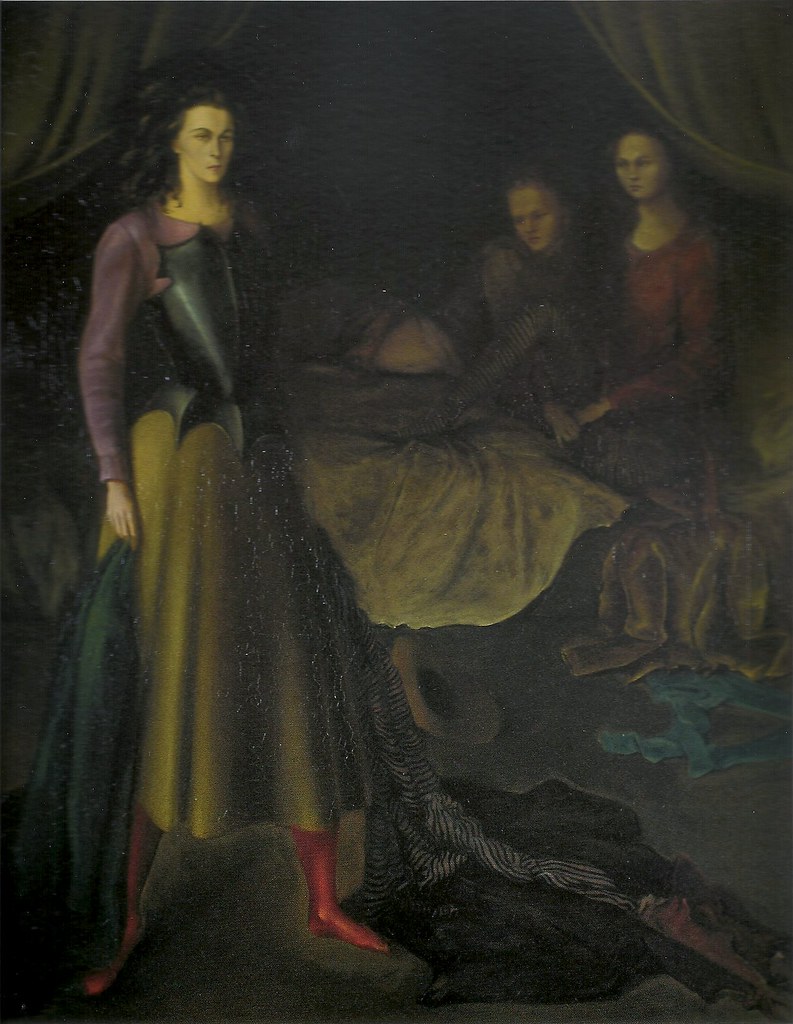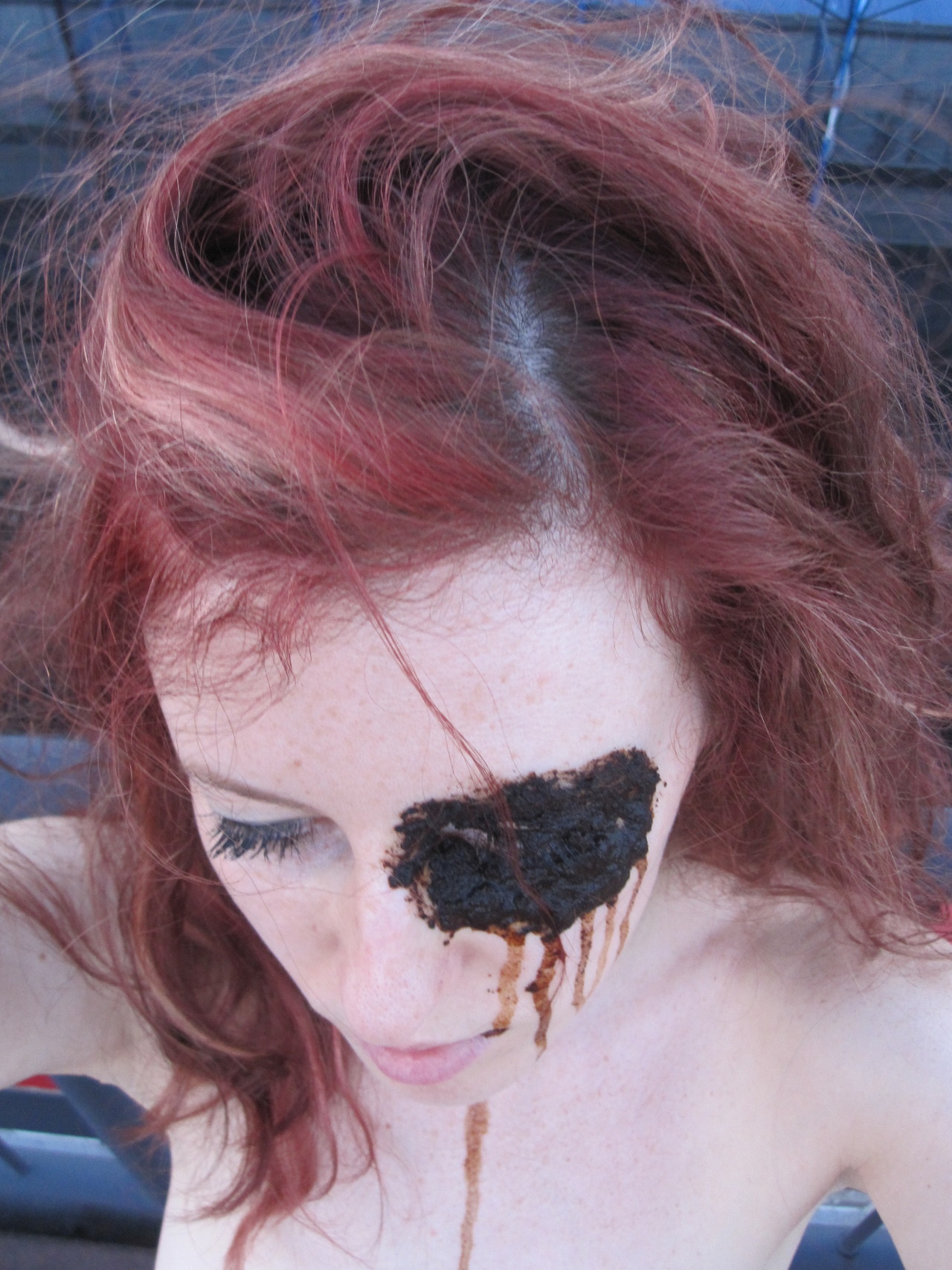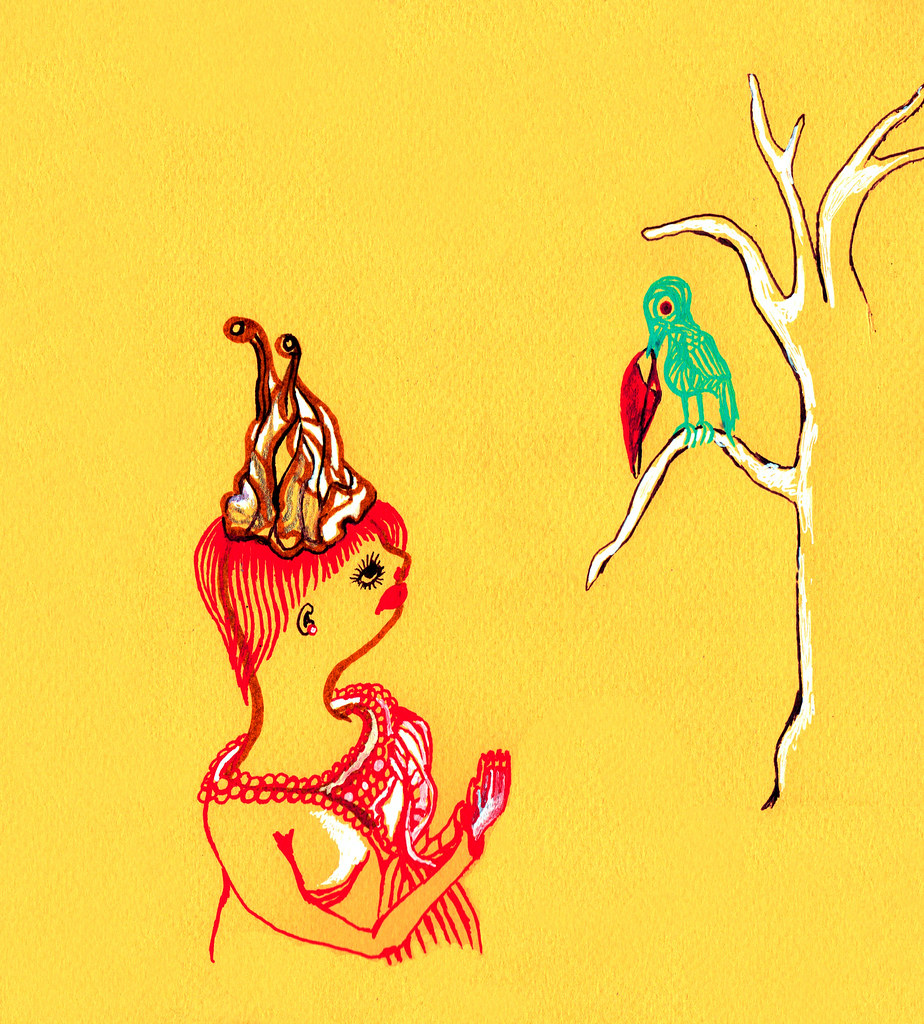Marginalia
on Absorption
by Amy King
Paint Is the Secretion of Scene on
Leonor Fini’s Set
I now confer
status on you. As in, everything is as
good
as the next thing. Better yet, in this season,
I am implicitly requesting your death
on a platter. That
said, should I begin without
interrogating
the
great mystery that separates
dark matter
from the everyday? Dive into beauty untinged by
the
detritus of degenerative mechanics? But
(my
own gut, packed with neurons,
neurotransmitters
and proteins that learn along
a
complex circuitry like and with the brain, balks
upon
thinking into such chasms. To begin
in
legitimacy is to acquiesce, to play like a harpsichord
down
the keys of your spine a deceit –)
the great lie
that lives lived are nothing
in
the considerations of art made, dissected
for channels of human knowledge – That
is, to instruct in
the room and board of sterilized parts.
Pardon my French. These
schools,
summoned by the handshakes of those
in the know, Order & brother Logic, condense
along the lines
of the social paradigm of the
day’s
matter. Or as Leonora Carrington
put it to a Freudian who once claimed
she was not adjusted,
with bow tied on:
“To what.”
So instead of
shelving cadavers “to what,”
I’ll begin in
tree time. When the Dogwood fell
from lightning
last winter, it lay in the park for months.
Powderpost beetles warmed, and the bark
held firm.
By April, its
horizontal body bloomed full white
blossoms
that met with spring’s fragrance everyone who
walked the paths along its limbs.
The Dogwood did not know it was dead.
It, lying in
its own knowledge, was alive and did not heed
otherwise.
It flowered for months its wine
with blood-tinged petals in tree
time.
Poet Paul Eluard
concurs,
“When it’s Fini, it begins.”
And so the approach.
Where is the vapor
barrier between “no children” and
“childless”? What contains a secreting absence?
Woman stands,
at key corners and check points,
for
the “(w)hole unfilled,” and makes
way in cultural stilettos daily. As it happens,
the space of
spiked nothings accommodates great deals.
So
Leonor Fini rejected marriage
as an institution and ducked the cloak
of motherhood
on
similar terms. Frida
Kahlo, a continent over,
submitted,
“Painting completed my life. I lost
three children… Painting
substituted for
all of this. I believe work is the best thing.”
(Crayon’s culture without adherence to
social
requirements. Breaking the seal of life without.)
When the
Surrealists convened to discuss
women’s
sexuality, only one man among them called
attention to
the absence of women, the diva panel.
A serious line of query: but little did
they take up,
in gestures toward liberation, how they
would
re-pivot the systems that position men
as
the primary discussants of women’s bodies
and
exactly in what way those reified daisies
should
be viewed and treated, in what rows
(and how).
So what way does she make? (How)
does she
make way?
An ego may be a stand-alone smokescreen,
a fiction in
translucent
gauze with items carefully pinned,
presenting the
world with the story of a person.
In two-way fashion, the gauze is a lens to
see through
too.
(I am talking about reading lives from the master I contest.
I
am writing as material interest, a gaping abyss.)
But this is
only one version. An ego is also an
interaction,
an interplay of psychic forces, not in
mere exchange,
but as colluding energies that manifest
ghosts.
An ego can be the plaything between, the
alchemical
threshold
of coming together, our third-element,
an
unnamable ghost that constructs something from
us, psyches
that meld and
mate,
dispersing matter. Enters, the
Sphinx.
(With an insurmountable sheen, Leonor
Fini
returns to the scene, with mask and
breasts and spikey mane,
attaching to the roof of one’s skull,
having swallowed hard
the glow of such names: witch, sorceress, la maga, mamba,
Lilith and Eve – she sees. Fierce and feline,
with one yawn against muse fantasy:
the energized conquest of femme-enfant.)
The Law of Intervention
In a letter to
Paul Demeny, Arthur Rimbaud submitted
that
the search for a new poetic language would
be transformed
if women broke from their servitude
and
sought their own ideas and forms.
As such, Leonor Fini’s friend and fellow
painter, Leonora Carrington believed
in
“a powerful female force rising”
but warned of
“vulgarizing
interpretations,”
believing
that
naming a power is to reconstruct it
in the masculine. Or as may be deduced,
signifiers are as cultural as economic.
What one crafts as the month’s aesthetic
flavor,
one may also reap in readings, jobs and
loot,
based
on the demands of logocentrism, or what
gets rolled out
in the “language of the father.”
Or as George
Carlin observed on fatherly
returns,
“You don't need a formal conspiracy
when interests converge. The owners of
this country
went to the same universities and
fraternities,
they’re on the same boards of directors,
they belong to the same country clubs,
they have
like
interests, they don't need to call a meeting because
they know what
is good for them...and they are getting it.”
Carrington,
like Fini, play-thinged with the Surrealists,
along
with a small crew of female artists and painters.
These associations drew sideways
beyond the frame,
either as a by-product of romance
(i.e. Carrington and Ernst),
or
as cloistered by Andre Breton himself, where, “The art of Frida
Kahlo is a
ribbon around a bomb.”
(Despite sleight use of
Surrealist-marked techniques, the women
wore the cloaks of fringe players or
further erased
themselves from muses to edge their art
beyond the laws Breton & friends serialized
and pounded out.
An interloper might speculate they intuitively
excused themselves to become something
the group could not delimit.)
Leonor
Fini had read Freud’s inner trappings by the time
she
was sixteen and was derailingly aware
of the good doctor’s
theories as Surrealism’s springboard.
Denuding said manifesto
hounds, she responded, “I
disliked the deference with which
everyone treated Breton.
I hated his anti-homosexual attitudes
and also his misogyny.
It
seemed that the women were expected to keep quiet
in
café discussions, yet I felt that I was just as good as the men.
Breton seemed
to expect devotion, like a pope, and wanted me
to become ‘a
sheep in his gang’. I enjoyed the attention
I received, but I refused to join his
group. I never
saw the point of being part of one
group, and I disliked
Breton’s
habit of holding tribunals, excommunicating
wayward
surrealists… publishing lists of books
one shouldn’t
read. I have never been very interested
in ideologies,
and I refused the label surrealist….
I preferred to walk alone.”
But
she did not walk alone.
She moved unsanctioned
in Fini time.
Living Is a Corner Lens that Makes Up
Space
In this, our late
capitalism cornering the market
on personal
wealth and satiation,
mutual
responsibility and social justice wilt
beside
assertions of power positions
and their objects
of inferior signification.
That
is, in corners.
Systems
are historical, and no group has yet
ousted
the set-up to replace it
with
fairness for all. Nor free-for-all.
We
call for more triumph-of-the-underdog stories
and casts and satiate ourselves cheering
the imminent
winner who will clamor to next in line,
top-side.
By the measure
of Real Housewives, Fini and Carrington,
both lovers of Max
Ernst at opposite times,
should have
hated one another. Instead, their
friendship
spurred their
development as painters
at a time when an
all-male revue ran the show,
war
loomed and dictates of the fairer sex were to
inspire
animosity, not camaraderie and nurturance.
Fini
engaged in all manner of friendships
and
romances that the avant-garde Surrealists
condemned
and declared distasteful.
What gets lost,
or dismissed, in the investigations
to change world
orders is as obvious as that question
posed by the
single Surrealist who noted the absence
of women in
discussion. That which is construed
as the feminine.
Here I do not refer to anything akin
to
de Beauvoir’s rejection of an “eternal feminine”
through
which men project transcendence as cave shadows.
Here
I do not ask for the simple exchange
of
maternal metaphors to battle phallic excess.
Here
I do not ask for adherence to “woman”
as metaphor for liberation
from Western mono-logical thought, or
shadow puppets.
Here I ask for
something ghostly and ghastly,
that which
systems of knowledge don’t notate
and attempt
mockery or ignore as the phantom of.
The real unreal. The irrational. An unbelievable turn
of shadow
boxers to brazen beautiful fists that shape & burn.
That
which is relegated to wayward worlds
of
emotion and nature, the pitiful and feared.
That
which shuns complicity by complicating with ambiguity
and
simultaneity. A particle in two places at once.
The
mercurial unfixed and uncertain transpiring
from consciously-crafted, studied
attempts.
Engagement with the intuitive and
what happens in
the material of communication.
That
which says my gut can think
and knows that black holes are still
hypothetical.
The
Accents of Collaboration
As
in, assess the difference in complexities
of
action with the Surrealist poet, Benjamin Peret,
yelling
his hatred for the church at passing priests
on
the street versus Fini donning a Cardinal’s scarlet
robes
to walk about Paris in sensual fashion
explaining
how she ‘loves to wear the clothes of a man
who
will never know a woman’s body’.
If “woman” is Foucault’s “discontinuous
and illegitimate knowledge” that counteracts
‘claims of a unitary body of theory which would filter,
hierarchize and order in the name of some true knowledge,’
then Jane Gallop pumps that heel:
Levi-Strauss says woman is both a sign and an
exchanger of signs, thus hers is the place in organized culture that evokes
another “more primitive” epistemology in which all objects were also considered
endowed with subjective status. Might not one of the goals of what we so
ambiguously call “women’s studies” be to call into question the oppressive
effects of an epistemology based on the principle of a clear and nonambiguous
distinction of subject and object of knowledge? Rather than attempt to banish
it, I would like to take advantage of the ambiguity of “women’s studies,” in
that it retains woman’s traditional peculiar vantage point as neither quite
subject nor object, but in a framework which sees that vantage as an advantage
and not a shortcoming.
Or
to put it mildly, why shouldn’t woman,
in
insurrectionary fashion, embrace her enigmatic,
precarious
state and confound
traditional
assignments by integrating myths
of
the masculine into her representations – and so forth.
Let’s
look to Fini’s The Alcove: An Interior
with Three
Women,
which, with the placement of a breastplate
on
Leonora Carrington, suggests the masculine
guardian
and protector, but the implications
are
conflated with the feminine
in
the form of confidant, lover, nurturer, etcetera,
vis-a-vis
the room’s intimacy, discarded clothing,
the
title’s suggestion of equal status, hands held,
gazes
exchanged. Thus the scene is no easy read –
it
is the setting of something indeterminate
and
simultaneously intimate and monumental.
Sink
into also Fini’s strategies
in light
of her statement to the writer, Rodriguez Monegal:
Men are basically less masculine than they think,
or than they pretend to think. It is a very old throw-back
at the expense of deeper ones ... I am for a world
of non-differentiated, or little-differentiated sexes.”
Her emphasis in depicting delicate and androgynous
male bodies draws out the suppressed feminine
qualities in men, which are not married to biology,
as well as culling a mercurial openness and curiosity
for female guidance as suggested in her painting,
In the Tower. Fini represents herself as well
In the Tower. Fini represents herself as well
in bold dress exposing cleavage, but the typical muse
and object of desire are eradicated
by her striking raven black contrasted
by her striking raven black contrasted
with the man’s red and nudity, her height, direct gaze
and obvious command at the illuminated portal.
Without
hazarding too deeply into reductive
readings
of Fini, one more footnote is in order
regarding
her self-portraits as sphinxes.
In Greek mythology, the sphinx was female,
half-human
and half-lion. Fini stated,
“I
remember I wanted to be like the sphinx I saw
in
the garden of Miramar Castle in Trieste. I wanted
to
think like it, to be strong and eternal, to be
a living sphinx. Later, I felt that the combination
a living sphinx. Later, I felt that the combination
of
half-animal, half-human was the ideal state.
I
identified with the hybrid.” The enigmatic nature
of
the sphinx renders the depiction, especially
in
the standard hierarchy, ever more complex.
Similarly,
Frida Kahlo has aligned herself
with
such hybridity; in The Little Deer
Kahlo is
severely
pierced and should be death itself, but her gaze is one
where
she dwells with the elements
(a
broken limb and lightning flash) around her.
Likewise,
both painters stand keen, firm-eyed, to explore
the
generative embrace of the less-than-ideal death
conditions,
decay and pain. They lay claim on these liminal states
in
the service of the transformation in the feminine subject.
Further, the farther away many of these painters got
from Surrealist tendencies, the more their mastery moved,
and elaborately their vocabulary grew.
They created beyond the stuff of Surrealist dreamscapes.
The abyss called out, and the yawns shifted on to
vertiginous
gaps.
Marginalia
Someone
may ask, what does a poet read in a painting?
Why the lives
of these women
who
removed themselves to gather in as from the margins?
To which I
might suggest that the margins
have gotten a bad rap. The theorist, bell hooks,
suggested their
value in the 90s, that choosing to work
from the margin “shapes and determines one’s response
to existing
cultural practice and one’s capacity to envision new,
alternative, oppositional aesthetic acts. It informs
the way we
speak about these issues, the language we choose.”
The margins as place of refuge have been popularly
shut down as
anti-social and self-isolating. Fleeting irrelvance. But this
misnomer is based on the notion that margins
are hermitry-inducing,
if one has the privilege of choice. Some cannot choose
the margins;
they are forced cages. For others, a reprieve
from which one may emerge and engage.
Thus one refreshing
aspect in the face
of these women and their rejection of the promise
of celebration
and liberation by a group seemingly full
of potential to debunk historical authority.
They made their
own way, affecting social conditions,
in various fashions, in their own time, without
the authorial
approval of a majority to proceed.
(Helene Cixious from another early text,
“Woman
must write her self: must write about women and bring
women to writing, from which they have
been driven
away as violently as from their bodies –
for the same
reasons, by the same law, with the same
fatal goal.
Woman must put herself into text – as
into the world
and into history – by her own movement.”)
The bodies left behind are painted and numerous.
Cixous would say, an ensemble. Some ghosts seek matter,
so between us we may need a medium to matter in,
to make matter in. Bodies are borders that work
in countless registers, and I am talking about reading
lives through and into the matter I seek.
I am, at this
point, unwilling, as a good citizen should be,
to divorce the
lives from what is produced and proceed
in my own time,
or tree or Fini time, to question that
which takes
place in the many pixelated, painted, and
molecular forms
mingling between us.
Since language “takes
place” in some material, I hope
to read ever more
bodies and explore the transfiguration
that occurs in
the “exchange” between writers, painters,
the text and
the reader, in all of the ghosts
borne from such
work.
Absorption, a Postscript
The
“Shocking”
torso
laid claim
to the market for eleven
years.
The hourglass bottle, woman, a dress
modeled after Mae West’s bodice,
full of fragrance. The
feminine.
The
lid of a flower bouquet works in
the
lilt of a woman’s for a ball of roses.
Transparent glass of dark amber serum.
Fini’s
adopted fetish for mannequins,
the
marrying kind. Appropriately,
her
adoption shifted the misogynist symbol
of
an armless, faceless, orificed body.
Penetrable. The
Fini twist turns that form
inaccessible; glass holds no holes. Transparent,
nothing
to witness, nothing to photograph.
The
beholder knows the interior as exterior.
A
conflated holster that performs the gaze’s
mechanics. Nothing
but reflection.
An
a priori looking. The desiring knows
only
one’s own flesh through the bodice.
With
looking into a glass bottle, Fini shows
them
to themselves, carnivorous cavities
in action. However,
through
use, not through vision, splashing
essence
along their torsos. The body becomes
a vacuum, and doubles, as wet presence symbolique.
Rather
than absence for the female consumer.
Social
butterfly, Mae West, sexual, desiring and
anti-subordinate. Bottle metonymy.
A
parody of desire with hips and breasts.
(Enter
Sheela na gig in Laura Mulvey fashion.)
Accessible item of whimsy, the defused
bomb
stings
the unwitting grabby consumer.
The bottle sings of fullness, with room for absence,
in transparency, its own abyss of
essence,
a
presence, this emptying vessel of beauty
that
shocks with the art of amber darkness clearing
to a world that contains only us.
-------------------
Of her most recent book from Litmus Press, I Want to Make You Safe, John Ashbery described Amy King's poems as bringing “abstractions to brilliant, jagged life, emerging into rather than out of the busyness of living.” King conducts interviews for VIDA: Woman in Literary Arts and teaches English and Creative Writing at SUNY Nassau Community College. Visit her online @ http://amyking.org for more.




































































































